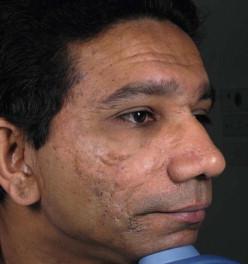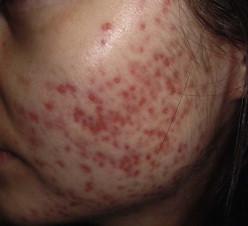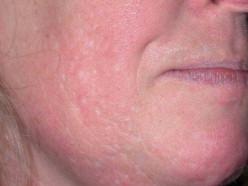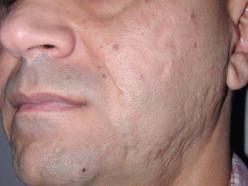Physical Address
304 North Cardinal St.
Dorchester Center, MA 02124
Post-acne scarring remains a common entity despite advances in our understanding and treatment of acne. The management of post-acne scarring remains as much an ongoing challenge as ever, with improvement not eradication as the goal.
This strategy or paradigm used in aesthetic dermatology concentrates on the effects of surface, volume and movement changes seen in the skin as we age and to improve our appearance in the case of deformity from acne.
A grading scale of disease burden will be used to illustrate the disease severity and subclassified into scar types. Then the requirement for surface, volume and movement related treatment will be analyzed and the most appropriate treatment suggested.
On occasion surgical techniques are required to supplement these procedures.
There are comparatively few methods of treating an acne scar and often several selected methods will need to be combined in the one patient to treat one difficult area of scarring and sometimes to treat different scars in the same patient. Simply put, one can:
Alter the color: Color may be the main visual clue to the presence of macular, atrophic or hypertrophic scarring. The technique employed is dependent on the offending color. Post-inflammatory hyperpigmentation is often the cause of brown marking perceived as “scarring” by the patient and is responsive to medical therapy with bleaching preparations and time, light chemical skin peeling, a variety of pigment lasers, light sources and the advent of fractionated lasers ( Fig. 20.1 ). Home skin care, vascular lasers or intense pulsed light and time may be all that is required for erythematous marking or scarring ( Fig. 20.2 ). Hypopigmented marking is more difficult and may require pigment transfer techniques although fractionated lasers have also been found useful ( Fig. 20.3 ).



Induce (or reduce) collagen: This is the most common method utilized in the treatment of post-acne scars. Inducing new collagen formation is a common pathway used by all resurfacing techniques from the most minor home care to superficial treatments such as microdermabrasion, light chemical skin peeling through to the deeper resurfacing techniques represented by medium and deep chemical peeling including the “CROSS” technique, skin needling or rolling, dermabrasion, ablative laser skin resurfacing (CO 2 , erbium), plasma skin resurfacing and fractional resurfacing. When treating hypertrophic and keloid scars, multiple and often periodically repeated therapies are required to change the excessive collagen production by the fibroblasts
Fill the scar: This includes autologous (autologous collagen, dermal and fat grafting) and non-autologous temporary, semi-permanent and permanent augmentation techniques and agents ( Fig. 20.4 ).

This is necessary when the scar is dystrophic, has a white base or is in the middle of a bearded area.
This category also includes a variety of “punch” techniques such as punch excision and punch grafting. These techniques treat punched out and ice-pick scars. Punch elevation leaves the original scar in place only higher in the skin. It is not appropriate when the scar base is poor or the scarring is in a heavily bearded area.
This is required when scars occur on the forehead and glabella area in an expression line, in the chin and lower jaw line or where excessive muscle activity acts on a scarred, atrophic and compliant area of skin. Relaxing this skin puckering, which may amplify the scarring, with the use of botulinum toxin may go a long way toward solving the problem, albeit temporarily ( ![]() ).
).
In search of a practical way of approaching a patient with post-acne scarring, a grading system has been devised that is based on the overall burden of disease the patient must bear. No practitioner can totally understand what an acne scarred patient experiences on a day-to-day basis, but there is value in an objective scale of severity for comparison and research purposes and for planning therapies ( Tables 20.1–20.4 ).
| Examples of scars | Treatment plan |
|---|---|
| Erythematous flat marks | Surface |
| Skin care | |
| Retinoids, topical anti-inflammatories | |
| Procedures | |
| Vascular lasers, fractionated non-ablative lasers | |
| Volume, movement, surgery | |
| No treatment options required | |
| Hyperpigmented flat marks (post-inflammatory marks) | Surface |
| Skin care | |
| Optimized home care (bleaching agents, sun protection, etc.) and light strength peels ± microdermabrasion | |
| Procedures | |
| Possibly fractionated 1927 nm lasers | |
| Pigment lesion lasers or intense pulsed light (IPL) if required | |
| Volume, movement, surgery | |
| No treatment options required | |
| Hypopigmented macular scars | Surface |
| Skin care | |
| Sunscreens and occasionally bleaching preparations to limit contrast | |
| Procedures | |
| Fractional non-ablative resurfacing | |
| Pigment transfer procedures | |
| Volume, movement, surgery | |
| No treatment options required |
| Examples of scars | Treatment plan |
|---|---|
| Mild rolling atrophic scars | Surface |
| Multiple treatments of one or more of the following: | |
| Skin needling or rolling | |
| Non-ablative non-fractional resurfacing | |
| Non-ablative fractional resurfacing | |
| Microdermabrasion | |
| Volume | |
| Dermal fillers and superficial dermal fillers | |
| Small soft papular scars | Volume (decreasing collagen) |
| Fine wire diathermy (FWD) | |
| May be fluorouracil injections if FWD unsuccessful |
| Examples of scars | Treatment plan |
|---|---|
| More significant rolling, shallow “box car” | Surface |
| Fractionated resurfacing – ablative or non-ablative | |
| Medical skin rolling | |
| Plasma skin resurfacing | |
| Ablative lasers (CO 2 /erbium) | |
| Dermabrasion | |
| Chemical peeling | |
| Volume | |
| Focal dermal fillers if localized | |
| Consider volumetric, deeply placed hyaluronic acid, hydroxyapatite or stimulatory agents (such as polylactic acid) if more generalized | |
| Movement | |
| Botulinum toxin to muscles in lower face in affected areas (chin, marionettes) or in sites (glabella, forehead) of maximal muscle movement | |
| Surgery | |
| Subcision | |
| Mild to moderate hypertrophic or papular scars | Surface |
| Vascular laser (surface color and volume) | |
| Volume (decreasing collagen) | |
| Intralesional corticosteroids and/or fluorouracil and/or combine with silicon sheeting |
| Examples of scars | Treatment plan |
|---|---|
| Punched out atrophic (deep “box car”), “ice-pick” | Surface |
| Trichloroacetic acid (CROSS technique if numerous, deep and small) | |
| Fractional resurfacing may be combined with CROSS | |
| If fewer and broader but still <4 mm in diameter, consider punch techniques (float, elevation, excision or grafting) – surgery, with or without subsequent fractional or ablative resurfacing techniques | |
| Marked atrophy | Volume |
| Fat transfer | |
| Volumetric filling with: | |
| hyaluronic acid or hydroxyapatite or | |
| stimulatory fillers such as polylactic acid or | |
| silicon (if fat or other fillers not feasible) | |
| Significant hypertrophy or keloid | Intralesional corticosteroids or fluorouracil may be supplemented with vascular laser |
| Atrophic or hypertrophic disease | Movement |
| Botulinum toxin often combined with fillers especially in lower face for atrophic disease | |
| As supplement to scar excision in atrophic or hypertrophic disease | |
| Surgery | |
| Bridges and tunnels, dystrophic scars | Excision |
| Punched out scars (deep “box car”) | Punch elevation if scar base is OK |
| Marked sagging and apparent redundancy | Occasionally rhytidectomy |
In essence:
Surface treatment revolves around altering the color of the scar as well as inducing or reducing collagen in the underlying tissue.
Volume requires augmentation or filling to increase volume deficits or sometimes decrease the volume in terms of hypertrophic scarring.
Movement involves neurotoxins to minimize the action of muscle on diseased, atrophic or sometimes hypertrophic scarring.
Surgical options include punch techniques, excision or subcision.
This chapter will attempt to view and utilize the reconstructive schema above and methods of assisting acne scars within the classification of scarring framework looking at the burden of disease ( Tables 20.1–20.4 ). Most appropriate treatments for each classification will be outlined for each scar type within these classifications and when that treatment is best applied will be described in detail. For example, ablative non-fractional laser skin resurfacing may be applicable for Grades III or IV scarring but would be described in the Grade III section; similarly, bulk filling may have applicability to Grades III or IV scarring but is at its best when employed in Grade IV, grossly atrophic scarring disease.
This pattern is all about the surface, and macular scarring can be erythematous, hyperpigmented or hypopigmented and is visible to an observer at any distance.
Movement, volume or surgical options have no bearing with this level of scarring. In this level of scarring the facial reconstruction paradigm focuses on improvement in the skin's surface. Color is highly important to patients, as we tend to judge the health and age of an individual based partly on the evenness of skin color. This type of scarring, although flat, is distressing to patients as it is obvious without make-up. Many female patients will apply concealers and thick make-up to camouflage marks but render themselves liable to secondary comedonal changes of acne cosmetica.
It probably is best considering vascular lasers in a patient where the predominant scar type is erythematous. However, it is worth knowing that it may have a positive effect on other atrophic and hypertrophic scar types if they are also present.
These may be useful for erythematous scars especially non-ablative 1550 nm fractional devices although specific references are lacking at this time.
A major contributing factor in the appearance of hypopigmented acne scarring is the contrast between the hypopigmented scars and surrounding skin. Hypopigmented scarring does not tan and will be contrasted against any surrounding areas of hyperpigmentation. Treatment should begin with sunblocks, bleaching preparations and any other required procedures.
A number of smaller studies and case reports have looked at hypopigmented scarring and suggest that the non-ablative 1550 nm laser may have some efficacy in treating these scars.
Another new mid-infrared wavelength, Thulium laser (1927 nm) is a superficial, non-ablative, fractional device and may be interesting for the treatment of post-inflammatory hyperpigmentation and melasma which commonly complicate acne or highlight hypopigmented scarring. In this circumstance, the hyperpigmented areas would be treated, decreasing the contrast between these and the hypopigmented scars.
Hypopigmented scarring has been reasonably refractory to treatment, although pigment transfer procedures have been attempted. There are a number of techniques utilized for treatment of vitiligo that may be useful in the treatment of hypopigmented scarring. Minigrafting holds some promise and epidermal suspensions both cultured and immediate non-cultured may also be useful. Re-Cell ® (Avita Medical Northbridge, CA) is a semi-automated kit that provides an immediately available, autologous, non-cultured epidermal suspension. Melanocytes in the suspension promote reintroduction of pigmentation into hypopigmented regions.
Pigment specific lasers and possibly intense pulsed lights as well as the Thulium 1927 nm fractionated laser, sun blocks and bleaching preparations remain the most likely to succeed with pigmented acne scars. This type of scarring is often little more than post-inflammatory hyperpigmentation although in some darker skin types it is a particularly long-lasting issue. Darker skinned patients may not be used to wearing sun protection, so they should be instructed specifically that they would need daily broad-spectrum sun protection.
Grade II acne scarring ( Fig. 20.5 ) is again mainly concerned with the skin surface. It is mild, atrophic or hypertrophic disease, which may not be obvious at a social distance (such as talking to someone in normal lighting) and is easily covered with make-up.

This type of scarring alters collagen reflectance in the scarred dermis, causing the loss of an even skin glow from shadows cast by the scars. This is particularly obvious to patients looking in the mirror or with lighting from above. Usually this is mild atrophic disease but occasionally mild papular acne scarring will produce small protuberances especially on the nose or chin.
In the facial reconstruction paradigm, skin surface improvement is achieved by increasing or reducing collagen. Mild volume changes such those offered by superficial dermal fillers like hyaluronic acids are also useful. Using our paradigm of surface, volume, movement, and surgical approaches, all of the approaches below are possible either as isolated treatments, or in combination. Most require multiple treatments and all may be used for multiple scars or localized areas although fillers are more applicable for localized disease.
Become a Clinical Tree membership for Full access and enjoy Unlimited articles
If you are a member. Log in here